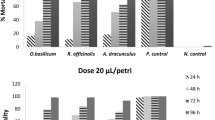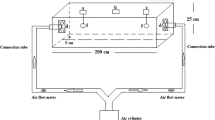Abstract
The present work aims to evaluate the insecticidal and repellent effects of essential oils from fresh leaves of Hyptis suaveolens and Ocimum canum against Tenebroides mauritanicus (L.) (Coleoptera: Tenebrionidaea) isolated from peanut in post-harvest in Benin. Chemical analysis of essential oils by GC and GC-MS indicated that, in the volatile extracts, different groups of terpene and terpenoid were present. The results of contact toxicity tests indicated that at a concentration of 0.5 µl of essential oil/g of peanut the mortality rate of Tenebroides mauritanicus (L.) is 100% after 24 h for the essential oil of Hyptis suaveolens, while it is still at 20% for the essential oil of Ocimum canum. Results also indicated that Hyptis suaveolens oil has a high repellent activity, when compared to the essential oil of Ocimum canum. This essential oil with high repellent and insecticidal properties represents a novel approach in the protection of grains against T. mauritanicus and the reduction of post-harvest losses.
Similar content being viewed by others
References
Adams RP (2007) Identification of essential oil components by gas chromatography/mass spectrometry. Allured Publishing Corporation, Carol Stream, p 804
Adda C, Atachi P, Hell K, Tamò M (2011) Potential use of the bushmint, Hyptis suaveolens, for the control of infestation by the pink stalk borer, Sesamia calamistis on maize in southern Benin, West Africa. J Insect Sci 11:1–13
Adjalian E, Sessou P, Odjo T, Figueredo G, Kossou D, Avlessi F, Menut C, Sohounhloué D (2015) Chemical composition and insecticidal and repellent effect of essential oils of two premna species against Sitotroga cerealella. J Insect 319045:6
Aktar W, Sengupta D, Chowdhury A (2009) Impact of pesticides use in agriculture: their benefits and hazards. Interdisc Toxicol 2(1):1–12
Aygun D, Doganay Z, Altintop L, Guven H, Onar M, Deniz T, Sunter T (2002) Serum acetylcholinesterase and prognosis of acute organophosphate poisoning. J Toxicol Clin Toxicol 40:903–910
Bassole IHN, Nebie R, Savadogo A, Ouattara CT, Barro N, Traore SA (2005) Composition and antimicrobial activities of the leaf and flower essential oils of Lippia chevalieri and Ocimum canum from Burkina Faso. Afr J Biotechnol 4(10):1156–1160
Campbell JM, Sarazin M, Lyons DB (1989) Canadian beetles (Coleoptera) injurious to crops, ornamentals, stored products, and buildings. Agricultural Canada, Ottawa, p 491
Coskuncu KS, Kovanci B (2005) Studies on the biology and distribution of cadelle, Tenebroides mauritanicus (L.) (Coleoptera: Trogossitidae) in Bursa, Turkey. J Entomol 2(1):17–20
de Billerbeck VG, Roques CG, Bessière JM, Fonvieille JL, Dargent R (2001) Effect of Cymbopogon nardus (L.) W. Watson essential oil on the growth and morphogenesis of Aspergillus niger. Can J Microbiol 47:9–17
Fandohan P, Gbenou JD, Gnonlonfin B, Hell K, Marasas W, Wingfield JM (2004) Effect of essential oils on the growth of Fusarium verticillioides and Fumonisin contamination in corn. J Agric Food Chem 52(22):6824–6829
Fournier D, Mutero A (1994) Modification of acetylcholinesterase as a mechanism of resistance to insecticide. Comp Biochem Physiol C Pharmacol Toxicol Endocrinol 108:19–31
Gnankiné O, Bassolé IHN (2017) essential oils as an alternative to pyrethroids’ resistance against anopheles species complex giles (Diptera: Culicidae). Molecules 22(10):1321
Isman MB (2006) Botanical insecticides, deterrents, and repellents in modern agriculture and an increasingly regulated world. Annu Rev Entomol 51:45–66
Jayakumar M, Elumalai K, Jeyasankar A, Raja N, Ignacimuthu S (2005) Biological activity of Hyptis suaveolens Poit (Lamiaceae) and Melochia chorcorifolia (Sterculiaceae) on cowpea weevil, Callosobruchus maculatus (F.) (Coleoptera: Bruchidae). J Entomol Res Soc 29(4):265–269
Kim J, Marshall MR, Wei CI (1995) Antibacterial activity of some essential oil components against five foodborne pathogens. J Agric Food Chem 43:2839–2845
Kim SI, Park C, Ohh MH, Cho HC, Ahn YJ (2002) Contact and fumigant activities of aromatic plant extracts and essential oils against Lasioderma serricorne (Coleoptera: Anobiidae). J Stored Prod Res 39(1):11–19
Koul O, Walia S, Dhaliwal GS (2008) Essential oils as green pesticides: potential and constraints. Biopestic Int 4(1):63–84
Lee BH, Annis PC, Tumaalii F, Choi WS (2004) Fumigant toxicity of essential oils from the Myrtaceae family and 1,8-cineole against 3 major stored-grain insects. J Stored Prod Res 40:553–564
Nesci A, Barra P, Etcheverry M (2011) Integrated management of insect vectors of Aspergillus flavus in stored maize, using synthetic antioxidants and natural phytochemicals. J Stored Prod Res 47:231–237
Phillips TW (1997) Semiochemicals of stored-product insects: research and applications. J Stored Prod Res 33:17–30
Prakash A, Jagadiswari R, Nandogopal V (2008) Future of botanical pesticides in rice, wheat, pulses and vegetables pest management. J Biopest 1(2):154–169
Raja N, Jeyasankar A, Jeyakumar VS, Ignacimuthu S (2005) Efficacy of Hyptis suaveolens against lepidopteran pests. Curr Sci 88(2):220–222
Rattan R (2010) Mechanism of action of insecticidal secondary metabolites of plant origin. Crop Prot 29:913–920
Rozman V, Kalinovic I, Korunic Z (2006) Toxicity of naturally occurring compounds of Lamiaceae and Lauraceae to three stored-product insects. J Stored Prod Res 43:349–355
Shaaya E, Kostjukovski M, Eilberg J, Sukprakarn C (1997) Plant oils as fumigants and contact insecticides for the control of stored-product insects. J Stored Prod Res 33:7–15
Shani A (2000) Chemical communication agents (pheromones) in integrated pest management. Drug Develop Res J 50:400–405
Zhang JS, Zhao NN, Liu QZ, Liu ZL, Du SS, Zhou L, Deng ZW (2011) Repellent constituents of essential oil of Cymbopogon distans aerial parts against two stored product insects. J Agric Food Chem 59(18):9910–9915
Acknowledgements
The authors are grateful to the Department of Food Engineering of Polytechnic School of Abomey-Calavi University for the financial support.
Author information
Authors and Affiliations
Corresponding author
Ethics declarations
Conflict of interest
The authors declare that there are no conflicts of interest.
Rights and permissions
About this article
Cite this article
Adjou, E.S., Chougourou, D. & Soumanou, M.M. Insecticidal and repellent effects of essential oils from leaves of Hyptis suaveolens and Ocimum canum against Tenebroides mauritanicus (L.) isolated from peanut in post-harvest. J Consum Prot Food Saf 14, 25–30 (2019). https://doi.org/10.1007/s00003-018-1195-4
Received:
Revised:
Accepted:
Published:
Issue Date:
DOI: https://doi.org/10.1007/s00003-018-1195-4




